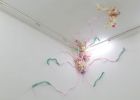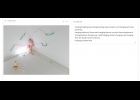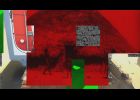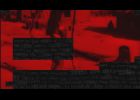“Devir em direção ao perecer”: Flusser, Plásticos, Rodas, e Inteligências Artificiais / "Becoming towards perishing": Flusser, Plastics, Wheels, and Artificial Intelligences
This essay proposes a digression on the permanence and impermanence, the visibility and invisibility of synthetic polymers (also known as plastics) and the role of AI, starting out from an interpretation proposed by Vilém Flusser in his essays “Forma e material” and “Rodas”. It explores the boundaries between form and matter, organic and synthetic, natural and artificial, art and science The text also includes a reflection proposed by Roland Barthes regarding synthetic polymers in his essay “Le plastique”, from the work “Mythologies”. The proteism of plastics could be interpreted as a utopia of total information. The text is accompanied by four images created by a Versatile Diffusion program.
Flusser’s Plantonic Philosophy
This essay examines the imagery of trees in Flusser’s works such as Natural:Mind, as well as shorter essays “On the Forest” [Da Floresta] and “Plant Film.” The figure of trees and plants cut across the different facets of Flusser’s corpus: from his employment of Husserlian phenomenology, to his retooling of Heidegger’s metaphysics, to his views on media thinking and the apparatus. Understanding his engagement with the plant world can help us understand his modernist method of thinking and the importance of language as a mediating apparatus for thinking. Together, these ideas about trees offer a unique view into Flusser’s thinking of media as a locus of innovation and resistance – two modernist concerns par excellence.
Pour un design radicalement circulaire. À propos des « Considérations écologiques » de Vilém Flusser
In his “Ecological Considerations”, an unpublished article written in French in 1984-1985, Vilém Flusser shows the limitations of a sharp opposition between nature and culture, and supports the provocative hypothesis of a naturalization of technology, which takes the form of a circular production. The notions of object and waste become the poles of a critique of consumption, which Flusser links to the development of digital programs and information theories. Examining this text, at a distance of nearly forty years, allows us to take a step back from the debates and controversies relating to the field of eco-design. It shows that a radically circular design would not change production and not even consumption, but the very definition of design.
Vilém Flusser et la recherche-création
This paper highlights some of the parallels and resonance effects that can be observed between the way Flusser advocated dealing with the “art crisis” and the way some institutions conceive and justify their “research-creation” programs today. Seen in this way, Flusser appears to have already been calling for a way of enhancing both research and creativity a half a century ago. We have yet to understand the epistemic, aesthetic and political implications of the specific method of interrogation he proposed (the Pilpul).
L’inter-code
In L’inter-code, a pseudo-random algorithm controls the appearance of zones of images and zones of text in mutual exclusion over the screen. The images include animations based on 3D models of objects exhibited in the Musée des Arts et Métiers in Paris: astronomical instruments which measure the infinitely big, a cyclotron which probes the subatomic world and above all, photo cameras adapted to the measure of space (photogrammetry). The images also include footages taken by the German ethnologist Theodor Koch-Grünberg in 1911 while living with the Taulipang tribe in Brazilian Guyana. The texts where extracted from the work of the philosopher Vilém Flusser, Towards a Philosophy of photography, which inspired this work. Strengthened by the soundtrack, this animation opposes Images and Texts in line with the ideas of Vilém Flusser: texts and images confront one another in the representation of the real world. This dialectical relationship, whose synthesis is yet to be discovered, is matched in the video by another opposition: tribal men living in equilibrium with nature, contrasting with the divergences of technical progress. By representing the biased relationship mankind maintains with the real when it is coded by texts and by images, L’inter-code seeks to question photographic image, not as the neutral product of a technique but as a complex construction that embeds a risk: the danger of increasing the distance between mankind and the world he inhabits. L’inter-code questions the possibilities and limits of science and its materialization in technology.
Biomedia and Anthropology of Gestures and Body
The essay is based on two central notions developed by Vilém Flusser: 1) life can be considered as a design project; 2) we are in need of a new anthropology of gestures. It moves from the modern understanding of technology, digital media and its cybernetic regime, to discover biomedia and their ability to invade and conquer bodies, senses and gestures. In the light of this new bio-techno-cultural constellation where media are used to design gestures, old questions about subjectivity, media and communication remain fundamental yet they ought to be reinterpreted.
2. Devil may care: Flusser’s Journey Into Exile and Beyond Reason
Vilém Flusser’s second book, A história do diabo (“History of the devil”), was published in Brazil in 1965 but has yet to be translated into more widely current languages. The present paper aims to summarize the major arguments contained in that early work, situating them in the cultural and intellectual context of the time. Taking Flusser’s personal history of exile as its point of departure, the paper suggests that the issues raised by the book are prescient of important changes in Western thinking over the past thirty years – in particular, the paradigm shift from the rational certainties of modernity to a more fluid notion of ‘reality’ in post-modernity. Flusser’s pioneering grasp of material appearances as “structures of virtuality”, elaborated through language, is indeed prophetic of things taken for granted in the digital era. For the student of Flusser, this important early work provides an insight into the profound unity underlying the multiple facets of his thought and writings.










